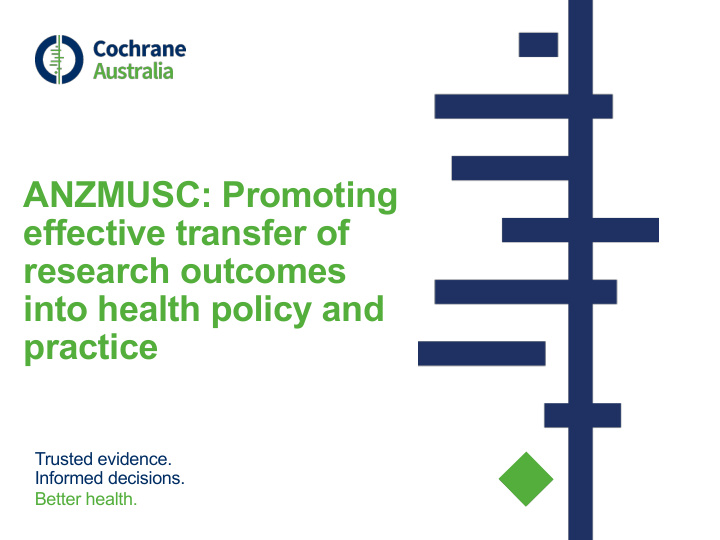



ANZMUSC: Promoting effective transfer of research outcomes into health policy and practice Trusted evidence. Informed decisions. Better health.
Disclosure of interests Director of Australasian Cochrane Centre Employee Monash University Funding from NHMRC, Cochrane, ACSQHC and DHA Physiotherapist in private practice
Research translation in the CRE Furthering the science of research translation for MSK conditions Perform implementation trials to evaluate what works to change practice Implement CCS for hip fracture and knee OA Develop living systematic reviews and living guidelines Effectively disseminate and translate the results of the CRE External advisory board Clinician researchers Annual national meeting Training opportunities in KTE Media and communications plan including range of outputs (policy briefs, consumer summaries, forums)
A common language for research translation • Ensuring stakeholders* are aware of and use research evidence to inform their health and healthcare decision- making • Ensuring research is informed by current available evidence and the experiences and information needs of stakeholders * stakeholders include: • healthcare professionals • consumers of health care (i.e. patients, family members, carers) • policy makers • educators • research funders • researchers Grimshaw et al, Implement Sci 2012
Research translation in the CRE Furthering the science of research translation for MSK conditions Perform implementation trials to evaluate what works to change practice Implement CCS for hip fracture and knee OA Develop living systematic reviews and living guidelines Effectively disseminate and translate the results of the CRE External advisory board Clinician researchers Annual national meeting Training opportunities in KTE Media and communications plan including range of outputs (policy briefs, consumer summaries, forums)
Health Practice Decision support Learning systems healthcare systems Hypotheses Knowledge Prioritisation translation Primary research Health 'big data' Living guidance Guidance Publication Publication Systematic review Linked data repositories Living evidence services Living systematic review Ellio% JH, Turner T, Clavisi O, Thomas J, et al. (2014) PLoS Med 11(2): e1001603.
An evidence ecosystem An new evidence ecosystem Health Practice Decision support Learning systems healthcare systems Hypotheses Knowledge Prioritisation translation Primary research Health 'big data' Living guidance Guidance Publication Publication Systematic review Linked data repositories Living evidence services Living systematic review Ellio% JH, Turner T, Clavisi O, Thomas J, et al. (2014) PLoS Med 11(2): e1001603.
The reality � The problem: systematic review production is inefficient and resource intensive Time from study to systematic review Ellio% JH, Turner T, Clavisi O, Thomas J, et al. (2014) PLoS Med 11(2): e1001603.
Survival of systematic review accuracy Shojania et al, Ann Intern Med. 2007;147(4):224-233.
Australian Guidelines: challenges 1. Inefficiency 2. Poor quality 3. Lack of capacity 4. Lack of investment in information technology 5. Inaccessibility 6. Obsolescence Better informed health care through better clinical guidelines: NHMRC Draft Discussion Paper, November 2015
PEOPLE PROCESS TECHNOLOGY Our response: Project Transform People + Process + Technology converge
Cochrane Crowd crowd.cochrane.org
28,000+ 911,442 3,485 RCTs/q-RCTs classifications contributors Cochrane Crowd crowd.cochrane.org
“There goes my social life. I'm hooked.” Kate, NGO worker, UK “What have you done? I got distracted by almost all the studies, wanting to read the whole articles. I just gave my husband snack food for tea as I don't have time to cook.” Charry, Medical Doctor, Australia
Pilot evaluation A backlog of 25,000 records Over 15,655 were deemed very unlikely to be RCTs by the machine. It was right for 99.9% of those 15,655
What is a Living Systematic Review? “Systematic reviews which are continually updated, incorporating relevant new information as it becomes available”
What are LSR methods? • Continuously updated • Active, ongoing evidence surveillance • Updates provided whenever new evidence, data or information is identified • Explicit, transparent, predefined decisions about: – How frequently new evidence is sought and screened; – When and how new evidence is incorporated into the review; – What thresholds cause the review to cease being ‘living ’ • No difference in core methods • Can be applied to any review type
How do LSRs differ from other reviews? Feature LSR Frequently Rapid updated SR Review Explicit methods for ‘when’ and ü X X ‘how’ of updating Continuous evidence ü ? X surveillance New evidence rapidly ü X X incorporated Standard SR methods ü ü X
When should I do an LSR? • The review question is a priority for decision making • There is likely to be a high volume of emerging research • There is capacity to maintain ongoing workflows
ANZMUSC research translation example Trials: arthroscopy self- management and exercise Implementation trials • Consumer support Evidence tools practice gap • Models of care • Implementation plans Living Living Guideline systematic CCS review
Recommend
More recommend